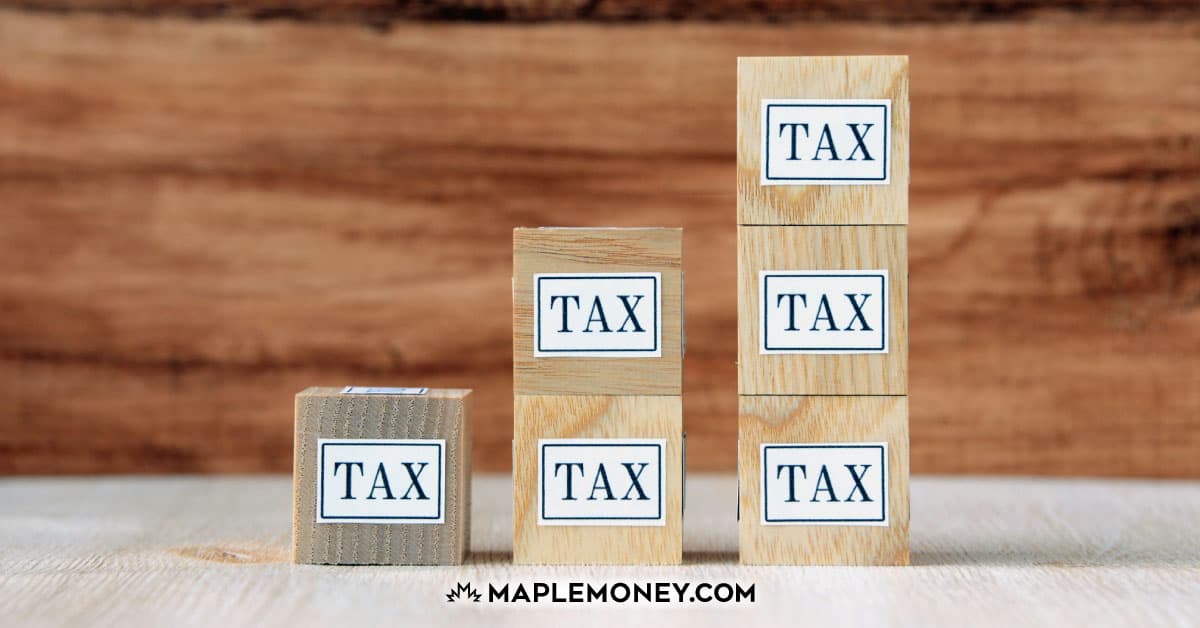2024 Canadian Tax Brackets: What You Need to Know

Most Canadians who earn income have to pay income tax every year, at the federal and provincial level. Yet most of us don’t have a true understanding of how our income taxes are calculated, or what tax bracket we fall into. If that’s you, you’re in luck. In this article, I’ve included a full list of tax bracket rates for Canada, as well as each province and territory. But before we dive into the numbers, let’s take a closer look at how the Canadian tax system works.
Canadian Income Tax 101
In Canada, we use a progressive income tax system. In other words, the last dollar you earn during the year is taxed at a higher rate than the first, unless your income is very low. The different rates are separated into different tax brackets, with each one covering a specific income range. The brackets are reset each year to account for inflation.
Federal tax rate example: 15% on the first $48,535 of taxable income, then 20.5% above $48,535 to $97,069
In addition to federal tax, you are required to pay provincial income tax for the province in which you live, but more on that later.
If you are a salaried employee, your employer is responsible for deducting a certain percentage of your income, for tax purposes. At the end of the year, the amount deducted and remitted to the CRA on your behalf should be fairly close to your total amount of income tax owing, although there are a number of factors that can result in you having to pay additional income tax when you file, or less. If, after reporting all of your tax credits and deductions, the CRA has collected too much income tax, you’ll be eligible for a refund.
Tax Credits vs. Tax Deductions
As you are probably aware, you can reduce the amount of income tax you pay using tax credits and tax deductions. Both are beneficial, but they are not one and the same. Here’s a basic rundown of how tax credits and tax deductions work.
Tax Credits
Tax credits are available at the federal and provincial levels. There are two types: refundable and non-refundable. A non-refundable tax credit reduces the amount of tax that you owe. The best example of this is probably the personal exemption amount. For 2020, it’s set at $13,229. When this amount is multiplied by the lowest federal income tax rate of 15%, it means that you won’t pay income tax on the first $13,229 of income you earn. This is very beneficial to low income earners and part time employees who may not have to pay any income tax as a result. Non refundable means that if the credit is higher than the amount of income tax you paid, the difference will not be refunded to you.
Refundable tax credits are paid to anyone who qualifies. The quarterly GST/HST benefit is a refundable tax credit. You receive a GST payment every three months as a refund on the tax you pay when you make purchases on goods and services throughout the year. This is available to Canadians with a low to modest income.
Tax Deductions
Income tax deductions don’t reduce your amount of tax owing, they lower your amount of taxable income. Two of the most well known tax deductions are Registered Retirement Savings Plan (RRSP) contributions, and charitable donations. For example, if you’re taxable income is $60,000, but you contributed $5000 to an RRSP during the year, your taxable income is reduced to $55,000. If you also donated $2500 to your favourite charity, your taxable income is reduced even further.
2020 Canada Tax Brackets
Without further ado, here is a list of all federal and provincial income tax brackets for 2020. I’ll include a few basic examples below of how you can calculate your own income tax rates in your province of residence.
2020 Federal Tax Bracket Rates
- 15% up to $48,535 of taxable income
- 20.5% between $48,535 and $97,069
- 26% between $97,069 and $150,473
- 29% between $150,473 and $214,368
- 33% on any amount exceeding $214,368
2020 Tax Bracket Rates by Province
Alberta
- 10% up to $131,220
- 12% between $131,221 and $157,464
- 13% between $157,465 and $209,952
- 14% between $209,953 and $314,928
- 15% on any amount exceeding $314,928
British Columbia
- 5.06% up to $41,725 of taxable income
- 7.7% between $41,726 and $83,451
- 10.5% between $83,452 and $95,812
- 12.29% between $95,813 and $116,344
- 14.7% between $116,345 and $157,748
- 16.8% on any amount exceeding $157,748
Manitoba
- 10.8% up to $33,389 of taxable income
- 12.75% between $33,390 and $72,164
- 17.4% on any amount exceeding $72,164
New Brunswick
- 9.68% up to $43,401 of taxable income
- 14.82% between $43,402 and $86,803
- 16.52% between $86,804 and $141,122
- 17.84% between $141,123 and $160,776
- 20.3% on any amount exceeding $160,776
Newfoundland and Labrador
- 8.7% up to $37,929 of taxable income
- 14.5% between $37,930 and $75,858
- 15.8% between $75,859 and $135,432
- 17.3% between $135,433 and $189,604
- 18.3% on any amount exceeding $189,604
Nova Scotia
- 8.79% up to $29,590 of taxable income
- 14.95% between $29,591 and $59,180
- 16.67% between $59,181 and $93,000
- 17.5% between $93,001 and $150,000
- 21% on any amount exceeding $150,000
Ontario
- 5.05% up to $44,740 of taxable income
- 9.15% between $44,741 and $89,482
- 11.16% between $89,483 and $150,000
- 12.16% between $150,001 and $220,000
- 13.16 % on the amount over $220,000
Prince Edward Island
- 9.8% up to $31,984 of taxable income
- 13.8% between 31,985 and $63,969
- 16.7% on the amount over $63,969
Quebec
- 15% up to $44,545 of taxable income
- 20% between $44,546 and $89,080
- 24% between $89,081 and $108,390
- 25.75% on the amount over $108,390
Saskatchewan
- 10.5% up to $45,225 of taxable income
- 12.5% between $45,226 and $129,214
- 14.5% on the amount over $129,214
2020 Tax Bracket Rates – Territories
Northwest Territories
- 5.9% up to $43,957 of taxable income
- 8.6% between $43,958 and $87,916
- 12.2% between $87,917 and $142,932
- 14.05% on the amount over $142,932
Nunavut
- 4% up to $46,277 of taxable income
- 7% between $46,278 and $92,555
- 9% between $92,556 and $150,573
- 11.5% on the amount over $150,573
Yukon
- 6.4% up to $48,535 of taxable income
- 9% between $48,536 and $97,069
- 10.9% between $97,070 and $150,473
- 12.8% between $150,474 and $500,000
- 15% on the amount over $500,000
Income Tax Calculation Example
Marginal Tax Rate vs. Average Tax Rate
The concept of marginal and average income tax rates can seem a bit confusing, so I’ll do my best to explain each one clearly. Your marginal tax rate is the rate of tax you pay on each additional dollar of income. Your combined marginal tax rate includes both federal and provincial rates. Here’s an example:
Let’s say you live in BC, and your annual income is $85,000. According to the CRA tax brackets above, your federal marginal tax rate is 20.5%. (total income falls between $48,535 and $97,069). As a resident of BC, you are taxed an additional 10.5% inside your provincial tax bracket, which included annual incomes between $83,452 and $95,812. Therefore, your actual marginal tax rate is 31%! If that sounds high, be grateful that you don’t live in Quebec or Manitoba.
The good news is that this doesn’t mean you’re going to pay $26,250 of income tax ($85,000 X 31%). That’s because you’re only paying 31% in the highest bracket. This is where your average income tax rate comes in, and it’s much lower, at 23.9%, reflecting a total tax payable of $20,242. Remember, by using the many tax deductions you have at your disposal, you can lower this amount even further.
In case you’re wondering, to get the average income tax I calculated the amount of income tax payable inside each tax bracket up to $85,000, for both federal and provincial. I added up the amount from each bracket to get the total payable, which I divided into $85,000 to get the federal and provincial rates. In this case they were 17.4% and 6.5% respectively. I then added the two together get the combined average tax rate of 23.9%
Canadian Tax Rates Summary
As a Canadian taxpayer, it’s important to understand the the basics of how tax brackets work. Sometimes, just seeing the amount of tax you actually pay is enough to get you motivated to find ways to pay less income tax. If this is something that interests you, you can learn more about income tax deductions on the CRA website, or check out our own guide to RRSP investing.


Comments
Great article Tom. Canadian tax system is ridiculously complex. I enjoy the challenge of trying to pay as little tax as possible, legally of course. As a semi retired person with a DB pension we managed to get our personal tax rate to under 8% on 65K. Important to understand tax brackets. Know more than a few colleagues with DB pensions who have to with draw RRSP money at the same tax bracket they put it in at.